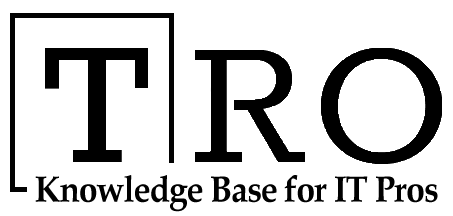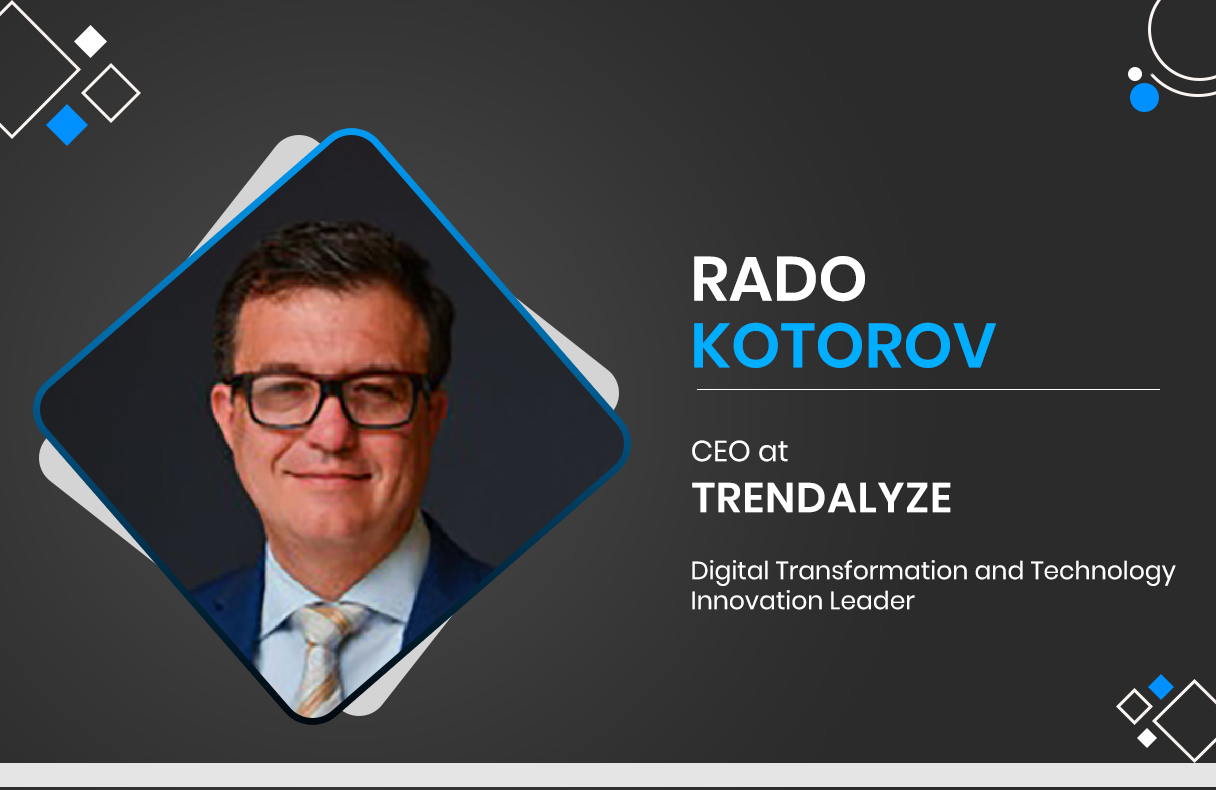Influencers Interview With Rado Kotorov – CEO at Trendalyze

Introduction
In today’s interview, we had the opportunity to speak with Rado Kotorov – CEO at Trendalyze
Rado Kotorov has a passion for new ideas and innovation, He is a proven leader in developing vision, strategies, and data-driven business models for the digital economy and a dedicated innovator who has co-created numerous software products and patented technologies. He is an author of two books “Organizational Intelligence” and “Data-Driven Business Models for the Digital Economy” and the Recipient of the 2019 NJ Digi-Tech Innovators Award.
1. Hey Mr. Rado Kotorov, Tell Us About Your Role and Journey as a Chief Executive Officer at Trendalyze. What Made You Choose This Profession?
Like many things in life, the profession chose me in a strange and serendipitous way. In 1994 Edward McClennen (one of the top scholars in Game Theory) offered me to join his Ph.D. program in Decision and Game Theory. He had read an article I had written and thought that I should continue with my research.
Funny enough, I did not know what Decision and Game Theory was. It turned out to be the science of how people make decisions and so I joined. It also so happened that all my jobs required me to work with data, build systems for data, and do the analysis. During my Ph.D. studies, I became CFO of a small company in Ohio and had to build the accounting systems, the point-of-sale system, all the reporting, and much more.
Then in 2000, I moved to NYC to work for one of the first web portal startups and we built the first massive-scale marketing automation systems that processed unimaginable amounts of consumer data for content personalization. Then I joined Information Builders where I was lucky to work closely with Gerry Cohen (a legend in the software industry) with whom I collaborated closely on many products and even a book.
In 2014, I saw the emergence of sensors collecting granular time series data and I realized that this is like the invention of the microscope. You can put any process or activity under the microscope and understand the root causes of everything. The granular data contained golden nuggets, but it required a new type of analytics that did not exist at the time. So, I rolled up the sleeves and started building Trendalyze.
2. Would you like to tell your Unique Skill that you think you have as a Technology Innovator and Digital Transformation Leader?
What is unique is the diverse collection of education and experiences that I accumulated over time. My CV is nonlinear – it is not a steady progression from one job title to the next in the same field or business domain. Instead, it is like a patchwork – jumping from one job or opportunity to another, from one field to another.
People, and especially corporate recruiters, look down on such nonlinear career paths. People do not choose such meandering paths; more often it happens because of life circumstances. But there is a value in it as it creates a tremendous interdisciplinary outlook on everything you do, which in turn allows you to put more things into perspective while also seeing details that others may miss.
It also makes people wiser and humbler as they are more aware of what it takes to learn new things. In our fast-changing world, we need more interdisciplinary training which today is not provided in universities nor can be acquired in a linear career path. To illustrate the benefits, on many occasions I have been acting as the ‘translator’ who can listen to business and express their thoughts in a language that IT can understand, then take that and translate it for the marketers, the accountants, the board members, etc.
Today, I find that it is extremely hard for one profession to understand the language of another. There is also a growing misconception about what makes interdisciplinary experiences valuable.
The interdisciplinary experiences that I describe are only valuable if one becomes a master of what they do every time they change jobs. Learning fast and deep is essential. If the gain from experience is shallow knowledge, then such an interdisciplinary guru is more dangerous than helpful.
Also Read: Interview With Anthony J James – Group CEO of Innovation and Growth
3. Would you like to Highlight, Some of the Focus Points on How to Solve Today’s Business Challenges by Using BI, Analytics, and AI 2.0, and 3.0 Technologies?
There is a perception that BI and Analytics can be automated, and users can just feed the data and magically get the results. We talk about autoML, automated insights, and other magical tricks. But people forget that analytics is reasoning. Do we have any AI that does reasoning? No. Does anyone think that we can anytime soon replicate with machines human reasoning? No. So how do we expect to get magical analytics?
We still need to train people in analysis and reasoning. I think the analogies between human intelligence and learning and “artificial intelligence” and “machine learning” are wrong. Machines are neither intelligent nor learn.
You may argue that a machine can play chess better than a human and that is true but is it intelligence? No. Chess is what game theorists call a finite game. The number of steps in the game may be huge but is finite. If you can compute fast and remember all the possible steps, you can instantly play all possible chess games. That is what the modern calculators do – compute and remember all steps. I think a better description of what AI is today is an analogy with search.
Machine algorithms build maps of patterns and remember them. As new data comes in the algorithms search and find known patterns. Where we are focused on is making this paradigm less complex and confusing so that ordinary people can do AI. We invented a Logical Neural Network that works on small data sets, is completely explainable, and can be done by business professionals. We took the magic out of the current art and made it humanly understandable and usable.
4. As you have Written the Book on “Data-Driven Business Models for the Digital Economy,” Please Share a Few Takeaways.
Well, you hear everywhere that data is the new crude oil. The gist of the book is about (1) how companies can ensure that they do not miss on opportunities related to data, and (2) how businesspeople should approach data monetization in a methodical way. The first question came from a conversation I had with a logistic operator. The company had all the technologies to track cars and connect clients with drivers using dispatchers.
As someone explained the company had the technology before UBER but never even thought about using it to create a new business model. Shareholders are right to be angry for missing out on such an opportunity. Yet, making money with data is very new.
There is no MBA program that teaches how to do it like they teach factory management, assets management, etc. Thus, people do not even know how to approach data monetization. Hence, we provided a framework. Different data requires different approaches. Putting an app does not guarantee success. One must carefully understand the data and what types of needs it may satisfy, but then also think about how it can be monetized because data monetization is not as direct as renting out a building.
5. Can you Throw some Light on Trendalyze’s Motif Discovery Algorithms, How this Works, and How this Helps to Deliver Fast Results Quickly and Lower Human Resources Cost?
Rather than talking about math, I prefer to explain its logic. Very often I hear people saying that they use this or that algorithm, but they cannot explain how the algorithms work on a logical level. Neural networks are black boxes, but this should not be the case. On a logical level, we should be able to explain their entire operations because they just extract correlations from the data. Today people simply expect that the algorithmic results are magically right.
That is bad because unless a person understands the logical operation of an algorithm, they may be doing the wrong thing. Trendalyze works like Google but instead of searching for words, it searches for patterns. Granular time series patterns have meaning to professionals.
Each pattern signals the need for some action. When cardiologists review ECG recordings and see certain patterns, they instantly realize what the diagnosis and the treatment should be. Signals like these can be used not just in healthcare but also in manufacturing to prevent defects, for detecting financial crimes and anti-money laundering activities, cybersecurity intrusion detection, environmental monitoring, and much more.
6. What is Next for you?
This field is evolving, and we still have plenty to do. So, I expect to be doing what I do now for the foreseeable future. But currently, my most important goal and task are to apply our logical neural networks to cardio patient monitoring. 80% of sudden deaths are cardio-related. The need for simple and more accurate automatic detection of cardio pathologies is huge.
And what we are working on is developing LNNs that can be configured with small data for each patient by medical practitioners. We are driving the personalization of algorithms, while everyone else is looking at the generalization of algorithms.
We flipped that upside down. And it will have a profound effect on data privacy because algorithmic personalization implies that the models can be protected in the same way as lab tests are protected today. The need to give all medical data for all patients to a single company to build a generalized algorithm disappears.
Also, Read Our Popular Blogs:
Best AI Assistant Of 2021| Best Data Visualization Tools 2021| How to Create a Dashboard in Power BI for Beginner | A-Z Tech BuzzWords in 2021 that You Should Know | Robotaxi Services: A Ride from Past to Future | Top 14 AI Startups to Watch Out in 2021 | Apple Airtag: A New Way to Track Your Stuff

